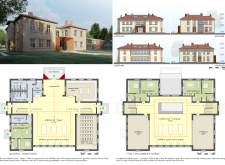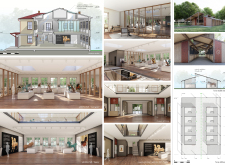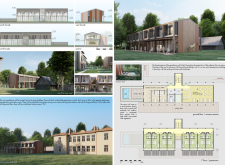5 key facts about this project
The Omuli Museum of the Horse is located in Latvia and serves to highlight local horse breeds through artistic workshops, exhibition spaces, and accommodations for visitors. The design places a strong emphasis on separating artistic functions from guest accommodations, providing a clear and logical organization of space. This approach enhances the project’s function as a community space while promoting education centered around equestrian culture.
Building Adaptation
The existing building will see minimal renovations to accommodate artistic activities such as workshops and exhibitions. This approach preserves the original structure and reduces costs associated with major renovations. The focus is on adaptive reuse, allowing the building's historical features to remain intact while still making it functional for modern purposes.
Guest Accommodations
A separate guesthouse will be constructed to offer eight rooms, each featuring private bathrooms and designated storage areas. This design prioritizes comfort for visitors while ensuring they are close to the museum’s activities. Shared living and dining areas, along with a traditional sauna, will contribute to a welcoming atmosphere and a sense of community among guests.
Phased Development
The project will unfold in three stages to effectively manage resources and time. The first phase includes establishing temporary workshops and essential facilities within the existing building. In the second phase, additional artist residences and a dedicated exhibition space will be introduced. The final phase will complete the construction of the guesthouse and stable facilities, which will feature a riding track that encourages engagement with local equestrian traditions.
Design Detailing
Corten steel is selected for the entrance of the existing building, enhancing visibility and drawing visitors in. The planned removal of two windows on the ground floor will create a more open feel, inviting the public to engage with the space. These design choices reflect a careful consideration of materials and functionality, supporting the museum’s mission of cultural education while providing a welcoming environment for all visitors.






















































